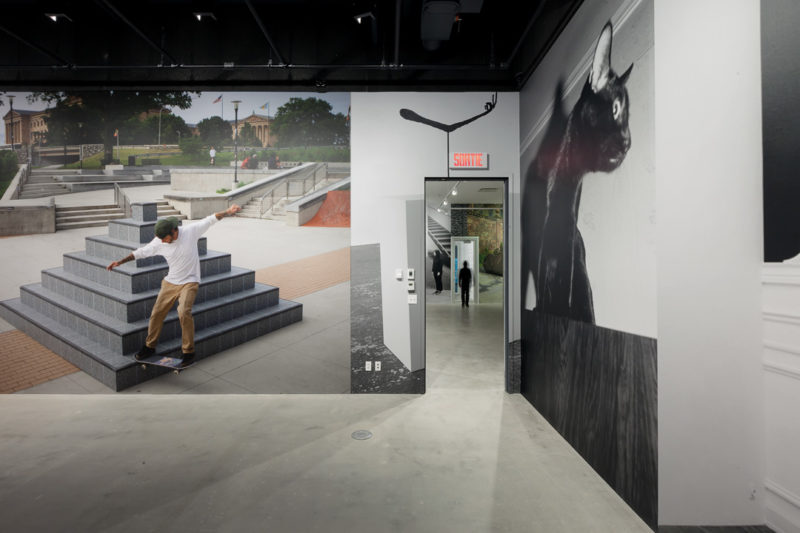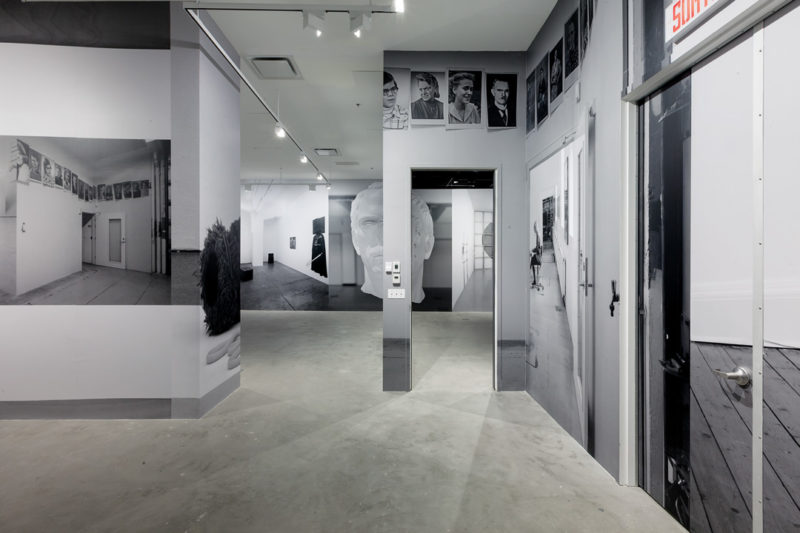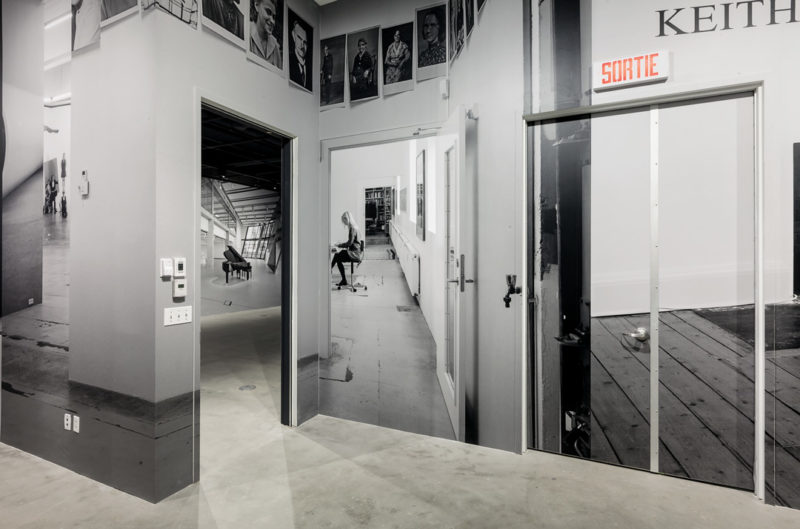[Spring-Summer 2018]
By Marie J. Jean
Exhibition views have taken on an increasingly important role since museum specialists began featuring them in exhibitions. Originally placed under glass, following a documentary protocol introduced via museology, this form of documentation has gradually come to be displayed on walls, occasionally ascribed the status of artwork, eventually attaining a monumental format and, as such, encouraging immersive experiences of documented exhibitions. Although its importance is now well established, especially with regard to the history of exhibitions, and although it has also been employed for the contextualization of past works and exhibitions, its use by artists has been little studied until now. For, in the hands of an artist, this documentation does more than actualize a past event: it ushers in a new way of practising exhibition-based art. The installation Exhibit Model by the British artist Jonathan Monk, with the many exhibition-related issues that it problematizes, will be the starting point for my reflection.1
Upon entering the gallery space and seeing Exhibit Model, visitors are immediately assailed by a powerful experience: immersion in an unrecognizable environment, strikingly different from what they are used to seeing. All of the walls have been covered in monumental images presenting various views of exhibitions, presented years apart, in different contexts. The views document multiple works created by Monk – shown in close-up as well as from a distance, head on as well as from oblique angles, in both colour and black and white – generating an experience of the space that is unusual, to say the least: at once labyrinthine and dizzying. The effect of these various exhibition spaces juxtaposed in this manner is not chaotic, however, as they have been assembled according to an overarching composition that establishes various formal relations and interactions with the architectural characteristics of the space that they cover. The wall of the building visible in one image, linked to a picture on a wall in the subsequent image, creates a strange volume: sometimes a power cord extends into the adjacent image; sometimes the connection is in the line of a shadow on the floor; other times, an infinite perspective is created by large window openings, generating an immediate effect of disequilibrium; at still other times, it is repeating doors (real or imaged) that result in spatial confusion. These exhibition views, employing the photomural format, arrange space unusually, and, although they do not result in the experience hinging solely on the spatiality of the image (its positioning in its environment) and spatiality in the image (the composition), they certainly provoke an unexpected relationship with place.
The environment puts us in a strange situation, as if, owing to a curious mise en abyme effect, we are led to progress simultaneously through spaces as varied as a commercial gallery, a public space, a museum, an apartment, and a book. This way of reconsidering the exhibition – that is, exhibiting the work along with its display context – reminds us that the work of art “is a place,” “institutes a place” and “takes place,” as German philosopher Martin Heiddeger has written.2 Heidegger establishes a distinction between works and their “exhibition,” by investigating more specifically the consequences of their “installation” in museums. He laments the fact that this display mode detaches works from their context, in turn diminishing the quality of their presence.3 Seeking to understand the effects of that decontextualization, he notes that when works are exhibited in a museum, they are preserved, contemplated, and studied, but, by being museified in this way, torn from their site of origin, they are constrained to offer themselves to us as “things,” as “objects of the art business.”4 How, then, can works escape from this “object-being” and retain their quality of presence?
Heidegger suggests there is an exit from that inevitability: “Where does a work belong?” he asks. “As a work, it belongs uniquely within the region it itself opens up.”5 Thus the “place” to which Heidegger refers to is not spatiotemporal, or historical, or the place in which the work stands: it is the “opening” that it institutes, and which he designates using the term “world” – a world that it is up to the work to “install” or “put in place.” It is surely a comparable experience, one that could be called “augmented reality,” to which we are summoned by the mechanism developed by Monk for Exhibit Model: although the work does not appear therein as an object (being represented, instead, in its documentary form), it clearly posits a “world” offering privileged access to what it was at the time of its original appearance and what it has become over the course of its exhibitions.6 This observation addresses an overall issue, which underlies a new way of thinking about the history of exhibitions that should be written based on the multiple narratives making up its diverse contemporaneities. It was therefore by design that the artist, during a public presentation, commented on the context of several works appearing in it, reminding us that the history of exhibitions is being written using the narratives that separate the original event from its successive reactivations.7
The environment created by Monk is striking not merely as a phenomenal presence: its impact is felt also in his unexpected use of exhibition views. This type of documentation has often been incorporated into exhibitions by museologists as a design element – for instance, monumental images showing artists in the studio – but curators have transformed them into reference tools for contextualizing historical exhibitions. Germano Celant, who incorporated Marcel Duchamp’s installation Sixteen Miles of String (1942) into the exhibition Ambiente Arte (37th Venice Biennale, 1976), was one of the first to employ such views. Jens Hoffmann has made abundant use of them, notably for the reconstitution of Live In Your Head: When Attitudes Become Form at CCA Wattis Institute for Contemporary Arts (Berne, 1969/San Francisco, 2012) and of Primary Structures: Younger American and British Sculptors at the Jewish Museum (New York City, 1966/2014), although the latter iteration was named Other Primary Structures, as artists of other cultures were included in a re-examination of the issues of exhibition from a global perspective. On that occasion, Hoffmann employed monumental documentation of the earlier exhibition on inclined walls to generate a dialogue between the reactivated works and the original installation parameters. Using his conception of the museum as global exhibition, Christian Bernard, director of the Museum of Modern and Contemporary Art in Geneva, has alternated between temporary exhibitions and displays of the institution’s permanent collection, in which he has regularly incorporated views of past exhibitions to emphasize the storyline of its history.
Investigating the reciprocal relationship between collection and exhibition, for the twenty-fifth anniversary of the Generali Foundation Helmut Draxler produced the “curatorial-discursive project” The Content of Form (2013), in which works about and photographs of exhibitions coexisted. Monumental enlargements of three historical paintings by Hubert Robert, David Teniers, and Johann Zoffany (depictions of exhibitions in an era when modern historical thinking was coming into being) were juxtaposed with works and exhibition views drawn from the history of the Generali Foundation, eloquently stating the relationship of interdependency that links works with their exhibition and demonstrating the role of that relationship in shaping the symbolic identity of the institution.8 Although this curatorial practice is becoming widespread in the twenty-first century, it must be remembered that it was artists who first experimented with its forms in ways that were just as daring, and often employing a reflexive approach.
The example of the Polish artist Edward Krasin´ski – who in 1968 was one of the first to make use of exhibition views as material for an exhibition – is quite instructive in this regard. Like conceptualists of his generation who shared a comparable formalist sensibility – Jan Dibbets and Bill Vazan come to mind – Krasin´ski limited his formal language to the line to create ephemeral spatial configurations, which he then documented using photography. On various occasions, he positioned blue adhesive tape in the gallery’s spaces – on the walls and on elements affixed to them – so as to interconnect diverse components of an exhibition, in the process creating complex (to say the least) spatial designs. As Paweł Polit has rightly pointed out, these designs tend to transform the gallery space into a subject of photographic representation.9 But Krasin´ski also employed photography in an utterly different way, incorporating images of prior shows into the exhibition itself, in the form of photographic tableaux. These were then connected to the other photographic or sculptural components of the exhibition by his lines of blue tape. This strategy summoned a new mode of (re)presentation, as if Krasin´ski had mapped out a narrative chain whereby the prior exhibitions acted as an introduction to the current one: the here and now could not exist other than in this linkage with the there and then. With this mise en abyme effect, he seemed to insist that the works and their display were in fact the object and the subject of his exhibition.
Seeking to transpose his outsized sculptures into a museum space, Michael Heizer has also employed photographic documentation of his works, enlarging the images so that they correspond to the grandiose format of the landscapes that the works occupy. Shown at the Los Angeles County Museum of Art in 2012, the installation Actual Size consists of enlargements of rocks that he had photographed in 1970, portrait-style, and Actual Size: Munich Rotary features projections of monumental images of a Land Art work that he created in Germany in 1969.10 These specific works were thus relocated so as to replay an effect of presence, which resided in the tension between the site of the work (the photographed landscape) and the space established by the monumental images (the exhibition). Croatian artist David Maljkovic´ has painstakingly devised stagings that include prior installation views, also presented as photographic enlargements, and placed beside works reconstituted for a new exhibition. Maljkovic´ produces contextual works that refer to the process during which they have undergone successive adaptations. Traditionally, the exhibition of a work has been seen, in a way, as its culmination, the ultimate step in which the artist’s production is finished. In fact, every new exhibition assigns a new display mode to the artwork. Maljkovic´ not only formalized this issue in the exhibition that he designed specifically for VOX, centre de l’image contemporaine (Montreal, 2016), but he also incorporated exhibition views that visitors had taken and posted to Instagram, recovering them and making them into photomurals. In so doing, he showed eloquently how the exhibition is at once a material and discursive mechanism and a mode of existence for an artist’s practice, at a given moment in his or her journey. Thus, for all of these artists, the use of documentation is no longer a staging device but an intrinsic component of their art. By extension, their approach investigates the modes of existence, circulation, and functioning of artworks within their diverse display contexts and, in the same action, obviates the modernist ideal of the autonomous work.
This is also one of the issues informing Monk’s Exhibit Model series; Monk, however, further delineates the issue by introducing an element of time to his images. Whereas his photo installation immediately calls to mind a monumental book whose pages unfold as one advances through the gallery (in which this type of photographic documentation would naturally be found), the spectator’s path through the space can also suggest an experience of time that appears cinematic. It is as if unexpected shots are intercut into the logical arc of a master sequence, revealing in one continuous movement the exhibitions that Monk has produced since the 1990s. The experience might also be compared to a succession of shots, conscientiously assembled end to end in the editing suite, at times suggesting a slowing-down and at other times a speeding-up, resulting from the association of various images, their variation, their articulation, and their repetition. Monk also makes abundant use of citation in his work, and one thing that characterizes this new iteration of Exhibit Model is mise en abyme. The spectator sees, in several places, the view of the same exhibition in previous versions, which represents a way of quickly summoning past events, actualized in the current experience. By embedding that documentation in a new sequence of images, he invites us to experience a reality augmented by a never-ending activity, wholly determined by its becoming. As a result, it becomes difficult to take in Exhibit Model globally, to grasp its implications and ramifications, without being caught off guard by the simultaneously spatial and temporal experience that Monk has so shrewdly staged.
Translated by Michael Gilson
2 Maud Hagelstein, paraphrasing Heidegger in “Art contemporain et phénoménologie,” Études phénoménologiques 41–42 (2005): 137 (our translation).
3 Martin Heidegger, “The Origin of the Work of Art,” in Off the Beaten Track, ed. and tr. Julian Young and Kenneth Haynes (Cambridge: Cambridge University Press, 2002), 20.
4 Ibid., 19.
5 Ibid., 20.
6 Exhibit Model 3, presented at VOX, centre de l’image contemporaine in 2017, including views of the previous two versions.
7 Public presentation at VOX, centre de l’image contemporaine, November 16, 2017.
8 On this subject, see Remi Parcollet, “Figures du ‘photomural’ exposé,” artpress 2 (issue: Les Expositions à l’ère de leur reproductibilité), no. 36 (February– April 2015): 48–54; Anne Bénichou and Francine Couture, “Une mise en crise du musée, un entretien avec Christian Bernard, directeur du Musée d’art moderne et contemporain à Genève (Mamco),” Muséologies 5, no. 1 (Fall 2010): 86–105; Helmut Draxler et al., A Book about Collecting and Exhibiting Conceptual Art after Conceptual Art (Vienna and Cologne: Generali Foundation and Walther König, 2013). On the origins of the photomural in exhibition practice, see Olivier Lugon, “Avant la ‘forme tableau,’” Études photographiques, no. 25 (May 2010): 6–41.
9 Paweł Polit, “Foksal Gallery and the Notion of Archives: Between Inventory and Place,” Afterall: A Journal of Art, Context, and Enquiry, no. 21 (Summer 2009): 114.
10 That action, which was as heroic as Heizer’s earlier creations, consisted of excavating a concave depression 4.5 m deep and 30 m across, which required moving some 1,000 tonnes of earth.
Marie-Josée Jean is executive and artistic director of VOX, centre de l’image contemporaine. Since the mid-1990s, she has organized more than a hundred exhibitions, including many at renowned institutions abroad. She was artistic director for the sixth and seventh editions of Le Mois de la Photo à Montréal, and in 2013 she received the Hnatyshyn Foundation Award for the excellence of her curatorial practice. She has just completed a doctorate at McGill University; her dissertation subject was the exhibition as a reflexive practice – an alternative history of artists’ exhibitions. She teaches at the Université du Québec à Montréal.
[ Complete issue, in print and digital version, available here: Ciel variable 109 – REVISITER ]
[ Individual article in digital version available here: After Jonathan Monk
, Exhibition Views as Augmented Reality
– Marie J. Jean ]





